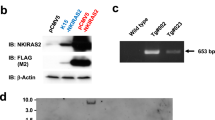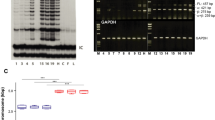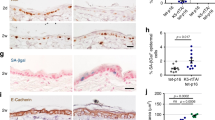Abstract
An important feature of the development of many human and animal tumours is the appearance of pre-malignant benign lesions, some of which undergo further changes during progression to malignancy1–4. Many of the currently accepted concepts of multi-stage carcinogenesis have been developed using an experimental model based on the chemical induction of tumours in mouse skin3,4. In this system, many of the pre-malignant papillomas which arise are promoter-dependent, and appear to regress if promoter treatment is interrupted, whereas others progress to form autonomous benign lesions and, in some cases, malignant carcinomas5. Although the number and nature of the events leading to malignancy are not known, DNA transfection experiments have led to the identification of several genes which may be qualitatively altered in tumour cells (see ref. 6 for review). We have previously shown that DNA from transplantable mouse skin carcinomas induced by chemical carcinogens has the ability to transform NIH/3T3 cells, and that the gene responsible for the transformation is an activated form of the mouse cellular Harvey-ras gene (c-rasH)7. We have now investigated the stage of carcinogenesis at which the proto-oncogene acquires transforming activity. We demonstrate that primary papillomas induced by chemical carcinogens in two different mouse strains have an activated c-rasH gene. This constitutes the first report of a benign tumour which contains DNA with detectable transforming activity. In addition, steady-state levels of c-rasH gene transcripts are elevated in the papillomas as compared with normal epidermis.
This is a preview of subscription content, access via your institution
Access options
Subscribe to this journal
Receive 51 print issues and online access
$199.00 per year
only $3.90 per issue
Buy this article
- Purchase on Springer Link
- Instant access to full article PDF
Prices may be subject to local taxes which are calculated during checkout
Similar content being viewed by others
References
Pierce, G. B. & Fennell, R. H. in Cancer Medicine (eds Holland, J. F. & Frei, E.) 149–167 (Lea & Febiger, Philadelphia, 1982).
Knudson, A. G. Cancer Invest. 1, 187–193 (1983).
Hecker, E., Fusenig, N. E., Kunz, W., Marks, F. & Thielmann, H. W. (eds) Carcinogenesis Vol. 7 (Raven, New York, 1982).
Boutwell, R. K. Crit. Rev. Tox. 2, 419–443 (1974).
Burns, F. J., Vanderlaan, M., Snyder, E. & Albert, R. E. Carcinogenesis Vol. 2 (eds Slaga, T. J., Sivak, A. & Boutwell, R. K.) 91–96 (Raven, New York, 1978).
Cooper, G. M. Science 217, 801–806 (1982).
Balmain, A. & Pragnell, I. B. Nature 303, 72–74 (1983).
Digiovanni, J., Slaga, T. J. & Boutwell, R. K. Carcinogenesis 1, 381–389 (1980).
Hennings, H. et al. Cancer Res. 41, 773–779 (1981).
Santos, E., Tronick, S. R., Aaronson, S. A., Pulciani, S. & Barbacid, M. Nature 298, 343–347 (1982).
Der, C. J., Krontiris, T. G. & Cooper, G. M. Proc. natn. Acad. Sci. U.S.A. 79, 3637–3640 (1982).
Parada, L. F., Tabin, C. J., Shih, C. & Weinberg, R. A. Nature 297, 474–478 (1982).
Shimizu, K., Goldfarb, M., Perucho, M. & Wigler, M. Proc. natn. Acad. Sci. U.S.A. 80, 383–387 (1983).
Pulciani, S. et al. Nature 300, 539–542 (1982).
Balmain, A., Krumlauf, R., Vass, J. K. & Birnie, G. D. Nucleic Acids Res. 10, 4259–4277 (1982).
Tabin, C. J. et al. Nature 300, 143–149 (1982).
Spandidos, D. & Kerr, I. B. Br. J. Cancer (submitted).
Armitage, P. & Doll, R. Br. J. Cancer 11, 161–169 (1957).
Moolgavkar, S. H. & Knudson, A. G. J. natn. Cancer Inst. 66, 1037–1051 (1981).
Cook, P. J., Doll, R. & Fellingham, S. A. Int. J. Cancer 4, 93–112 (1969).
Reddy, E. P., Reynolds, R. K., Santos, E. & Barbacid, M. Nature 300, 149–152 (1982).
Ellis, R. W. et al. J. Virol. 36, 408–420 (1980).
Author information
Authors and Affiliations
Rights and permissions
About this article
Cite this article
Balmain, A., Ramsden, M., Bowden, G. et al. Activation of the mouse cellular Harvey-ras gene in chemically induced benign skin papillomas. Nature 307, 658–660 (1984). https://doi.org/10.1038/307658a0
Received:
Accepted:
Issue Date:
DOI: https://doi.org/10.1038/307658a0
This article is cited by
-
Peto’s paradox revisited: black box vs mechanistic approaches to understanding the roles of mutations and promoting factors in cancer
European Journal of Epidemiology (2023)
-
Integration of multiple biological contexts reveals principles of synthetic lethality that affect reproducibility
Nature Communications (2020)
-
Deciphering the cells of origin of squamous cell carcinomas
Nature Reviews Cancer (2018)
-
Distribution bias analysis of germline and somatic single-nucleotide variations that impact protein functional site and neighboring amino acids
Scientific Reports (2017)
-
Cutaneous wound healing through paradoxical MAPK activation by BRAF inhibitors
Nature Communications (2016)
Comments
By submitting a comment you agree to abide by our Terms and Community Guidelines. If you find something abusive or that does not comply with our terms or guidelines please flag it as inappropriate.



